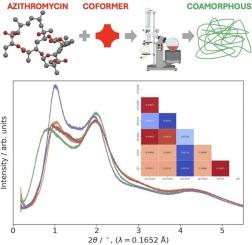Structural insights into novel coamorphous systems of azithromycin with faster dissolution profile
IF 4.3
2区 医学
Q1 PHARMACOLOGY & PHARMACY
European Journal of Pharmaceutics and Biopharmaceutics
Pub Date : 2025-09-21
DOI:10.1016/j.ejpb.2025.114873
引用次数: 0
Abstract
In this study, azithromycin, a broad-spectrum antibiotic compound used for the treatment of several bacterial infections, which is characterized by a very low water solubility, was combined with different small molecules to generate more soluble coamorphous solids. The multicomponent systems were prepared through fast precipitation from an ethyl acetate solution, facilitating the formation of amorphous phases in seven azithromycin-based systems. Differential scanning calorimetry confirmed the coamorphous nature in five out of seven systems (i.e., azithromycin–2-, 3-, and 4-aminobenzoic acids, –salicylic acid, –caprylic acid), while two systems (azithromycin–methyl salicylate, –glycerol) exhibited ambiguous thermal behavior. Stability assessments revealed that the homogeneous coamorphous systems remained stable for at least 140 days at 40 °C, while pure amorphous azithromycin, recrystallized within 72 h. The most suitable coamorphous systems were characterized through pair distribution function analysis, providing molecular-level insights into their structural organization. Notably, the azithromycin–caprylic acid system exhibited distinct molecular packing, likely attributable to the unique structural characteristics of its fatty acid-based coformer, which also led to a faster drug dissolution rate compared to the pure crystalline and amorphous azithromycin forms.

具有更快溶解谱的新型阿奇霉素共晶体系的结构见解。
在这项研究中,阿奇霉素是一种广谱抗生素化合物,用于治疗几种细菌感染,其特点是水溶性非常低,与不同的小分子结合,产生更可溶性的共晶固体。以乙酸乙酯溶液为原料,通过快速沉淀法制备了多组分体系,促进了7种阿奇霉素基体系中非晶相的形成。差示扫描量热法证实了7个体系中的5个(即阿奇霉素-2-,3-和4-氨基苯甲酸,-水杨酸,-辛酸)的共无定形性质,而2个体系(阿奇霉素-水杨酸甲酯,-甘油)表现出模糊的热行为。稳定性评估显示,均相共晶体系在40 °C下至少保持140 天的稳定,而纯无定形阿奇霉素在72 h内重结晶。利用对分布函数分析进一步表征了最合适的共晶体系,为其结构组织提供了分子水平的见解。值得注意的是,阿奇霉素-辛酸体系表现出明显的分子堆积,这可能是由于其脂肪酸基共构象的独特结构特征,这也导致了与纯晶体和无定形阿奇霉素形式相比,更快的药物溶解速度。
本文章由计算机程序翻译,如有差异,请以英文原文为准。
求助全文
约1分钟内获得全文
求助全文
来源期刊
CiteScore
8.80
自引率
4.10%
发文量
211
审稿时长
36 days
期刊介绍:
The European Journal of Pharmaceutics and Biopharmaceutics provides a medium for the publication of novel, innovative and hypothesis-driven research from the areas of Pharmaceutics and Biopharmaceutics.
Topics covered include for example:
Design and development of drug delivery systems for pharmaceuticals and biopharmaceuticals (small molecules, proteins, nucleic acids)
Aspects of manufacturing process design
Biomedical aspects of drug product design
Strategies and formulations for controlled drug transport across biological barriers
Physicochemical aspects of drug product development
Novel excipients for drug product design
Drug delivery and controlled release systems for systemic and local applications
Nanomaterials for therapeutic and diagnostic purposes
Advanced therapy medicinal products
Medical devices supporting a distinct pharmacological effect.

 求助内容:
求助内容: 应助结果提醒方式:
应助结果提醒方式:


